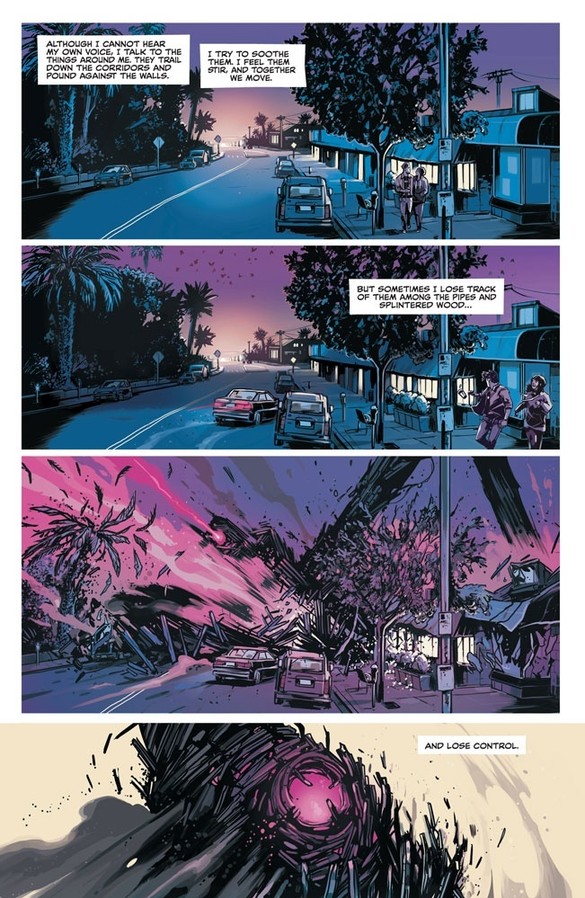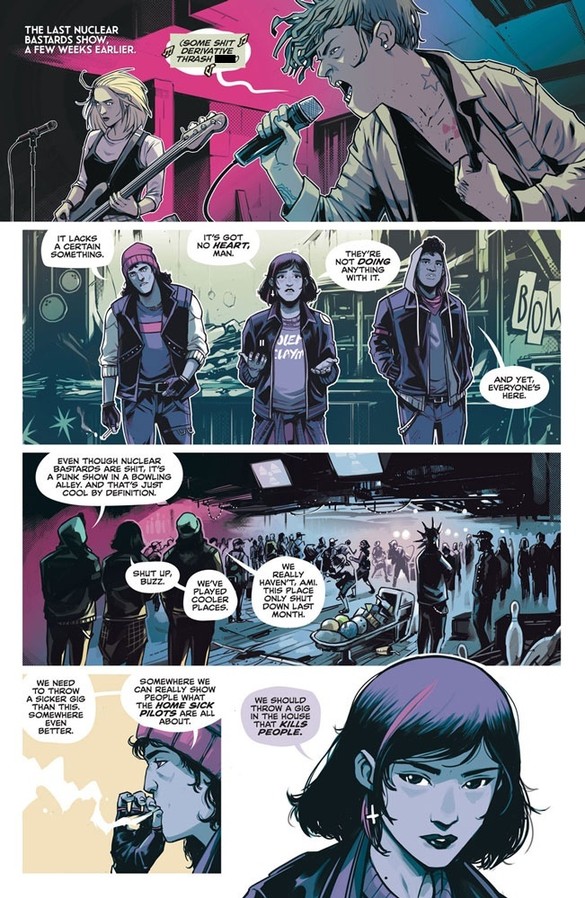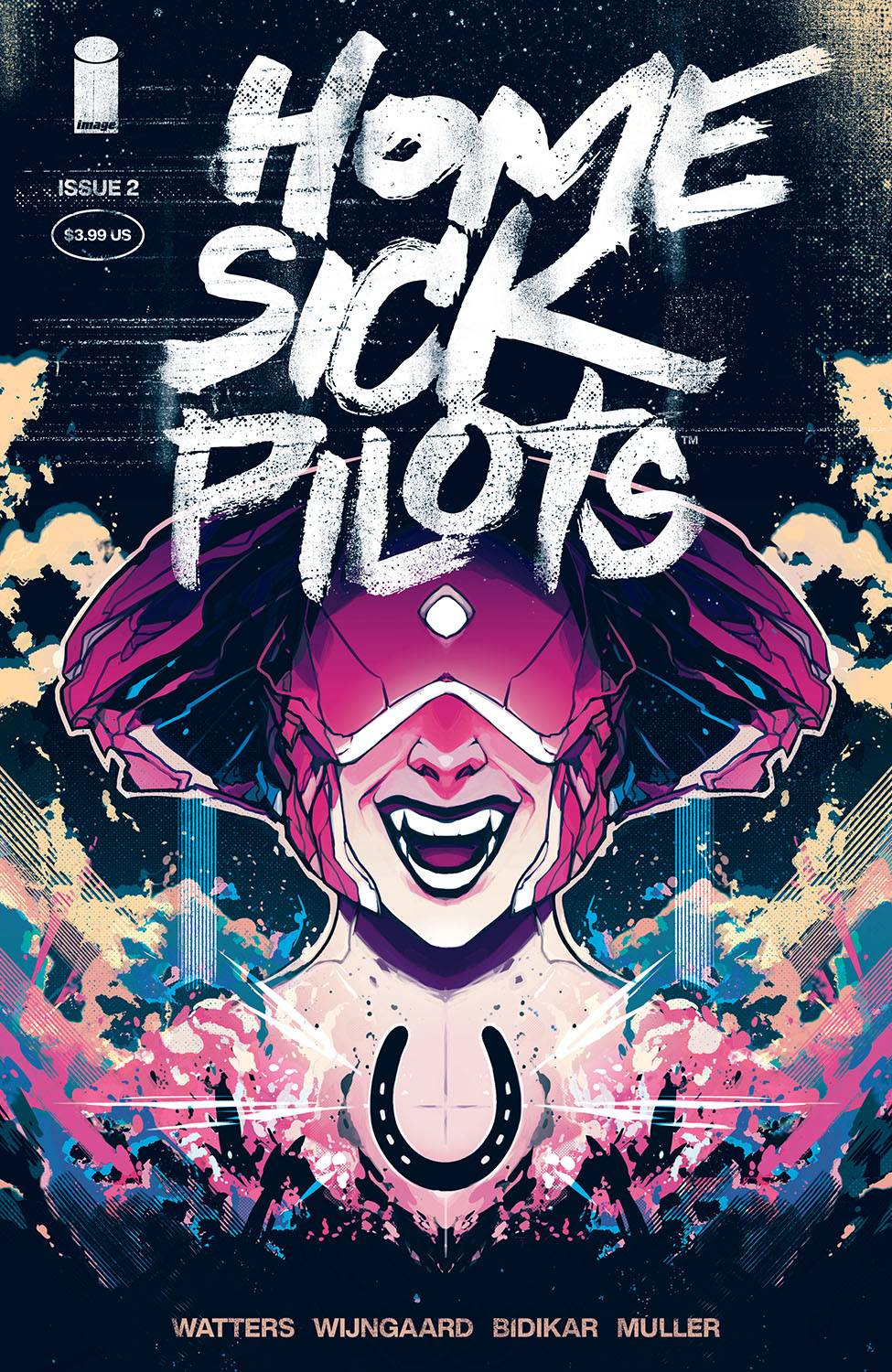
A grunge rock horror story is hitting shelves just in time for Christmas with Home Sick Pilots #1. In the summer of 1994, a haunted house walks across California, piloted by the lead singer of a high school punk band. The mystery behind how she got there and what these ghosts want will be answered in the Image Comic series debuting this December.

Home Sick Pilots reunites writer Dan Watters (Coffinbound) and Caspar Wijngaard (Doctor Aphra), who worked together previously on the series Limbo. This new series tells horror stories of adolescence as well; piloting haunted houses like a three-story Megazord built of all sorts of trauma and wood.
With the ongoing series debuting December 9, Newsarama spoke with Watters and Wijngaard about the book, their favorite ghost stories, the characters' relationship outside of their band, and what the Home Sick Pilots sound like.
Newsarama: Dan, Caspar, so I've read the first three issues and I'm curious to know what the elevator pitch was for Home Sick Pilots. Even trying to describe to friends is very difficult to do. So how would you describe the series?
Dan Watters: [Laughs] The original elevator pitch was "the story of a girl who falls in love with a haunted house," but I would say their relationship's gotten a little more complicated since then.
Caspar Wijngaard: The Hollywood pitch was "Power Rangers meets The Shining." However, I'm fairly certain our pretentious asses were calling it "House of Leaves meets Tetsuo: The Iron Man" when we were originally showing people the pitch treatment.

Nrama: In your head, what do the Home Sick Pilots sound like as a band?
Get the best comic news, insights, opinions, analysis and more!
Watters: Very fast, because their tactic is 'if a song is fast enough, no one can tell if you're playing out of time.' They're probably really hoping to get signed to Lookout Records, but not actually doing anything about making that happen. They're just enjoying themselves. They definitely cover Operation Ivy's 'Knowledge' at every show, because it's only three chords and very hard to screw up.
Wijngaard: Not great, I imagine 60% of their set is covers, but they have enough individual character and stage bravado to kick ass at live shows, so you probably wouldn't notice they suck.
Nrama: So let's break down the characters here and what they're about. We have Amida, Billy, and Rip. What can you tell us about their relationship, even outside of being in a band together?
Watters: They were all missing things in their lives before they found each other. None of them have parents in their picture, which is kinda why they picked their band name- so they lean on each other for support. They're more a family than a band; they spend most of their time together, but probably only practice once a week. Each one of them kinda is a total pain in the ass, but which punk kid isn't?

Wijngaard: There's a sibling dynamic at play, they all care about each other wholeheartedly for better or worse, they operate best as a group. Once you take a piece away the foundations start to crack, and weakness begins to surface. They'll need to learn to trust themselves as individuals again if they are to overcome the hurdles set out after the events of issue one.
Nrama: I want to talk about Caspar's colors here because I wanted to know if they're coded in any way. For your time jumps and fight scenes, especially, how did you want to switch things up? Did you try any other color palettes before going with the cool tones?
Wijngaard: I definitely knew going in that the action scenes would shift tonally, Red is universally known as a color signifier for danger and energy.
I applied muted colors on characters and environments on sections of the book that were meant to feel safe, in the hopes that the sudden palette change should create a noticeable visual prompt for the reader to know that the pacing and threat had changed. It also looks really cool, I won't deny it was also a stylistic choice.
Nrama: The book takes place in the early '90s, summer of '94 at least for the first issue. What comics were you reading in 1994?

Watters: The Very Hungry Caterpillar. I was three years old, but I stand by the book choice.
Wijngaard: Spawn! I was 11/12 in '94 and Spawn and Gen 13 were the coolest comics; I was also reading a lot of manga and Dark Horse.
Nrama: Do you feel like it's hard to balance horrific elements with coming of age stories, or something that works more naturally? I mean there's It, obviously, but did you find it a weird juggling act when creating this world?
Watters: I think it's a genre that works well. Coming of age is sodding terrifying. Everything feels entirely life-or-death, so in a story like this, you just nudge things so that they actually are. I guess the balancing is in making sure that everything doesn't disappear so deep into the horror angle that the everyday anxieties get entirely lost.
It's interesting to see how characters respond to complicated situations - if the situation is intense enough, I suspect the majority of us respond by screaming 'f--- oh f---' and running as fast as we can in the opposite direction.
Nrama: How would you describe the ghosts in the James house and how magic works in this world?

Watters: I'm obsessed with ghosts and ghost stories. I always think of ghosts as a big old trauma metaphor, and traumas are a big part of what makes us, us. So what I thought was interesting was the idea of actually letting them actually affect the world around them in specific ways related to their death or the unfinished business that has kept them around. They're somewhat poltergeist-y in that respect.
I guess that's also kinda where the Power Rangers element comes in, with different powers and ectoplasmic abilities being doled out, with ghosts latching onto people.
Nrama: Do you have a favorite ghost story?
Watters: I do love the classics. I read M.R. James's 'Oh, Whistle and I'll Come to You, My Lad' when I was about eight years old. It's set on the grey and stormy English coast, and involves the sheets of the unused spare bed in the narrator's hotel room sitting up in the shape of a figure and attacking him. I read this white-knuckled, on the car trip to my grandmother's house, on the grey and stormy Northern Irish coast, where I then stayed in a room which had an unused spare bed. I don't think I slept a wink for that entire trip. I come back to that story, over and over. To my mind, it's pretty much the platonic form of the ghost story.

Nrama: Caspar, how would you compare your work and style here with Peter Cannon, or even Doctor Aphra?
Wijngaard: For the most part my Star Wars and Cannon work were black and white, bar the Doctor Aphra Annual. So off the bat, I'm unable to have the same amount of freedom as I would when I color; it's not in my head so I have to draw with another collaborator in mind. Don't get me wrong, I enjoyed the hell out of those books, drawing these characters was and probably will be for some time a career highlight.
However, there is always a technical element in play when you're working with popular IP's and legacies, you have a huge responsibility to deliver for the fans as a fan. With a creator-owned series, I have absolute freedom to create without limitations.
Nrama: One thing really tying the book together is Aditya Bidikar's lettering and Tom Muller really going all out with the designs. What did you want out for logos or did you let Tom have carte blanche?
Watters: We were pretty involved in all of that. We were definitely trying to capture a specific spirit and the style of an era. We would send Tom a bunch of logos, bands, skate companies, all that good stuff. And then he'd absolutely nail it. We didn't actually go through that many iterations of the logo for the Home Sick Pilots themselves. We wanted something that looked like high school Kids would have drawn on their school books… but actually good. Tom nailed that balance pretty immediately.

Aditya is one of my favorite collaborators; we've worked together since I did Deep Roots at Vault, and he's so good at catching the wavelength I'm going for with each project. He came to Home Sick Pilots with these uneven, manga-influenced balloons, which I just love.
Wijngaard: I have wanted to collaborate with both Aditya and Tom for such a long time and I knew this book would be the perfect fit. We were very excited once both had agreed to join the project. There was a punk gig poster aesthetic we really wanted to capture in pages of the book, from Tom's awesome logo, photocopy credit pages, and covers treatments, to Aditya's handwritten lettering and unique approach to speech balloons. It all looks fantastic.
Nrama: Did both of you have a playlist to work to that was specific to the book?
Watters: We did, to the extent that we've collated one - which we really need to get round to releasing before issue one! A lot of '80s and '90s punk, a lot of grunge. The Home Sick Pilots' taste probably runs a little poppier than my own, so I've been listening to bands like the Descendents and Jawbreaker for the first time in years.
Wijngaard: Yes, mine was very mid-'90s Los Angeles KROQ. Lots of Offspring, Jane's Addiction, Bush, Nirvana, Smashing Pumpkins, Stone Temple Pilots, and a huge dose of Nine Inch Nails.
Home Sick Pilots will be available in both print and digital editions. Check out our list of the best comic readers for Android and iOS devices.
Lan Pitts likes watching, talking, and writing comics about wrestling. He has mapped every great taco spot in the DC and Baltimore areas. He lives with his partner and their menagerie of pets who are utterly perfect in every way.


